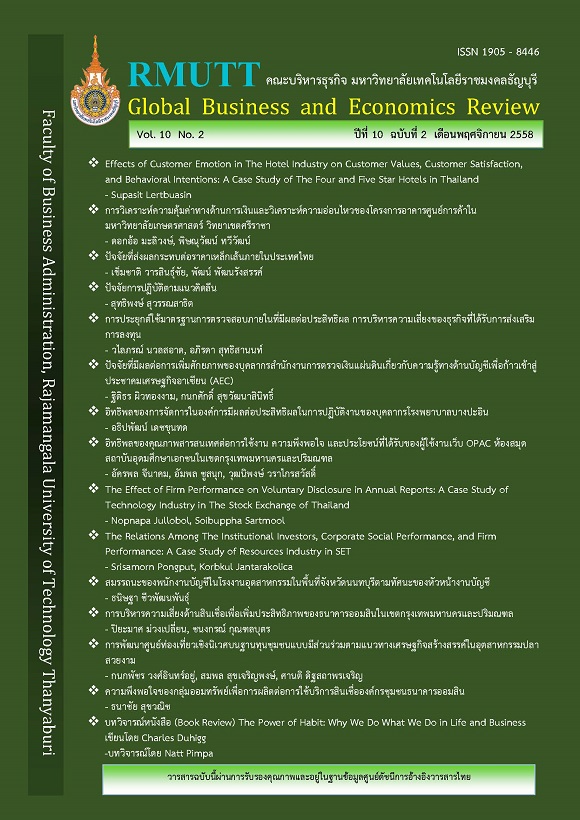EFFECTS OF CUSTOMER EMOTION IN THE HOTEL INDUSTRY ON CUSTOMER VALUES, CUSTOMER SATISFACTION, AND BEHAVIORAL INTENTIONS: A CASE STUDY OF THE FOUR AND FIVE STAR HOTELS IN THAILAND
Keywords:
Pleasure, Arousal, Hedonic Value, Utilitarian Value, Customer Satisfaction, Behavioral IntentionsAbstract
The main purpose of this study is to propose an integrated model that investigates the relationships among two components of customer emotion; pleasure and arousal, two components of customer values; hedonic value and utilitarian value, customer satisfaction, and behavioral intentions in the hotel industry. This study was a mixed methods research with the explanatory sequential design which first implemented in quantitative data collection and analyzed and follow up to qualitative tool by in-depth interview and analyzed. A total of 779 questionnaires were collected from four and five stars hotels customers in four regions of Thailand and statistical analyzed with SEM techniques by LISREL 8.80. The results of study demonstrates that pleasure directly and indirectly effects behavioral intentions meanwhile arousal influences behavioral intentions through mediators either utilitarian or customer satisfaction, or both. Future research should study in the segment of one to three stars rating hotels in order to confirm the research findings. The next research for hotel industry could study in other marketing variables such as brand equity, brand image in this research model. In addition, it could acclimatize to other hospitality sectors in Thailand such as restaurant, entertainment, sport etc.
References
Bigne, J. E., Andreu, L., & Gnoth, J. (2005, December). The theme park experience: An analysis of pleasure, arousal and satisfaction. Tourism Management, 26(6), 833- 844.
Choi, T., & Chu, R. (2001). Determinants of hotel guests’ satisfaction and repeat patronage in The Hong Kong hotel industry. International Journal Hospitality Management, 20, 277-297.
Creswell, J. W., & Plano Clark, V. L. (2011). Designing and conducting Mixed Methods Research (2nd ed.). Los Angeles: SAGE Publications. Cronin et al. (2000). Assessing the effects of quality, value, and customer satisfaction on consumer behavioral intentions in service environments. Journal of Retailing, 76(2), 193-218.
Field, A. (2005). Discovering statistics using SPSS (2nd ed.). Thousand Oaks, CA: Sage Publication.
Hair, J. F., Black, W. C., Babin, B. J., & Anderson, R. E. (2010). Multivariate data analysis (7th ed.). Upper Saddle River, New Jersey: Prentice - Hall.
Irani, N., & Hanzaee, K. H. (2011). The effects of variety-seeking buying tendency and price sensitivity on utilitarian and hedonic value in apparel shopping satisfaction. International Journal of Marketing Studies, 3(3), 89-103.
Keillor, B., Hult, G. T., & Kandemir, D. (2004). A study of the service encounter in eight countries. Journal of International Marketing, 12(1), 9-35.
Kim, B., & Oh, J. (2011). The difference of determinants of acceptance and continuance of mobile data service: A value perspective. Expert Systems with Applications, 38, 1,798-1,804.
Ladhari, R. (2007).The effect of consumption emotions on satisfaction and word of mouth communications. Psychological Marketing, 24(12), 1,085- 1,108.
LeBlanc, G., & Nguyen, N. (1996). An examination of the factors that signal hotel image to travelers. Journal of Vacation Marketing, 3(1), 32-42.
Lindeman, R. H., Merenda, P. F., & Gold, R. Z. (1980). Introduction to bivariate and multivariate analysis. Glenview, III: Scott, Foresman.
Manhas, P. S., & Ramjit, J. (2013). Customer experience and its relative influence on satisfaction and behavioral intention in hospitality and tourism industry. South Asian Journal of Tourism and Heritage, 6(1), 53-68.
Mehrabian, A., & Russell, J. A. (1974). An approach to environmental psychology. Cambridge, MA.: Massachusetts Institute of Technology.
Qin, H., & Prybutok, V. R. (2008). Determinants of customer-perceived service quality in fast- food restaurants and their relationship to customer satisfaction and behavioral intentions. The Quality Management Journal, 15(2), 35-50.
Rovinelli, R. J., & Hambleton, R. K. (1977). On the use of content specialists in the assessment of criterion referenced test item validity. Dutch Journal of Educational Research, 2, 49-60.
Russell, J. A. & Pratt, G. A. (1980). A description of the affective quality attributed to environments. Journal of Personality and Social Psychology, 38(August), 311-322.
Ryu, K., & Han, H. (2011). New or repeat customers: how does physical environment Influence their restaurant experience?. International Journal of Hospitality Management, 30, 599-611.
Ryu, K., Han, H., & Jang, S. S. (2010). Relationships among hedonic and utilitarian values, satisfaction and Behavioral intentions in the fast-casual restaurant industry. International Journal of Contemporary Hospitality Management, 22(3), 416- 432.
Schiffman, L. G., & Kanuk , L. L. (2000). Consumer Behavior (7th ed). Upper Saddle River, NJ.: Prentice-Hall.
Walsh, G., Shiu, E., Hassan, L. M., Michaelidou, N., & Beatty, S. E. (2011). Emotions, store- environmental cues, store-choice criteria, and marketing outcomes. Journal of Business Research, 64(7), 737-744.
Wakefield, K. L., & Blodgett, J. G.(1996). The effect of the servicescape on customers’ behavioral intentions In leisure service settings. The Journal of Service Marketing, 10(6), 45-61.
Yamane, T. (1967). Statistics: An introductory analysis (2nd ed). New York: Harper and Row. Yuksel, A. (2007). Tourist shopping habitat: Effects on emotions, shopping value and behaviours. Tourism Management, 28, 58-69.
Yuksel, A., & Yuksel, F. (2007). Shopping risk perceptions: Effects on tourists’ emotions, satisfaction and expressed loyalty intentions. Tourism Management, 28, 703-713.
Zeithaml, et al. (1996). The behavioral consequences of service quality. Journal of Marketing, 60(2), 31-46.
Downloads
Published
How to Cite
Issue
Section
License
The articles published in this journal are the intellectual property of their respective authors.
The views and opinions expressed in each article are solely those of the individual authors and do not reflect the positions of Rajamangala University of Technology Thanyaburi or any of its faculty members. All components and content of each article are the sole responsibility of the respective authors. In the event of any errors, the authors shall bear full responsibility for their own work.








